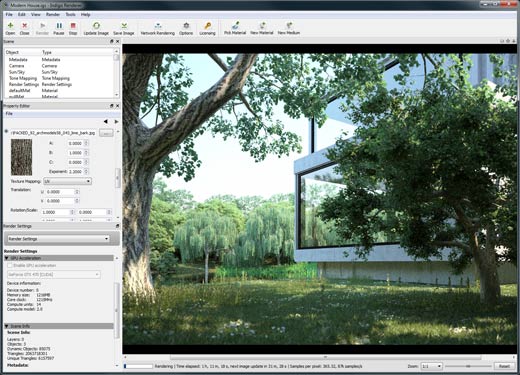Indigo RT is a new rendering solution which delivers unmatched value in the high end rendering market: it is the first robust, truly unbiased and full-featured rendering system available at under €100 (for the duration of the sale; normal price is €145).
Indigo is an unbiased, physically based and photo-realistic renderer which simulates the physics of light to achieve near-perfect image realism. With an advanced physical camera model, a super-realistic materials system and the ability to simulate complex lighting situations through Metropolis Light Transport, Indigo is capable of producing the highest levels of realism demanded by architectural and product visualisation.
GPU Accelerated
Indigo 3.0 introduces real-time scene editing – now you can tweak your materials, and the results will be displayed nearly instantly.
You can tweak materials, camera position, camera f-stop and focal length, all in real time, with both a ray-traced and OpenGL preview.
Animation and Render Queue Support
Indigo now has built-in animation and render queue support, thanks to the introduction of the Indigo Queue (.igq) format.
Render queues integrate smoothly with network rendering, which means you can use all the computers on your network to render an animation or set of images easily and rapidly.
Faster, More Powerful
Many changes resulting in improved rendering performance and image quality have been made in the core. Indigo 3.0 produces better images for the same number of samples per pixel as 2.x.
Indigo 3.0 also introduces optional camera vignetting and faster HDR environment mapping.
These are just a few of the many changes that have been made to the core rendering engine in Indigo 3.0 – with many more still to be introduced!
Seamless Network Rendering
All the new Indigo 3.0 features work seamlessly with network rendering, which means you can harness the full power of your network to accelerate realtime editing and final rendering.
Indigo 3.0 network rendering has been greatly optimised since 2.x. Files are intelligently cached on render nodes, resulting in faster render startup times.
Render queues integrate seamlessly with network rendering, allowing for fast rendering of animations and batch jobs.
Many Fixes and Improvements
Bump mapping is now more accurate, especially with strong bump scaling and in regions of high curvature. Even models with relatively few polygons benefit from the visual quality added by bump maps.
Subdivision and displacement has been greatly improved, with much better UV mapping behaviour and support for mixed triangle+quad meshes. This dramatically improves the quality of subdivided meshes compared to first triangulating them and then applying triangle-based subdivision.
For more information: www.glaretechnologies.com.
Sections: Business Technology
Topics: Press Release City
Did you enjoy this article? Sign up to receive the StudioDaily Fix eletter containing the latest stories, including news, videos, interviews, reviews and more.

Leave a Reply